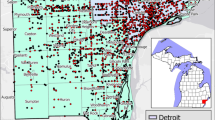Abstract
Although the goal of brownfield development is to clean up and redevelop abandoned or underutilized properties in distressed urban neighborhoods, the racial and socioeconomic disparities of brownfield cleanups have not been adequately examined. This study combines the locations of brownfields with 1990 and 2000 US Census data in the Detroit region. Results reveal that brownfields located near socioeconomically disadvantaged neighborhoods tend to be cleaned up first. Brownfields located far from major roads also tend to receive priority. However, results also suggest that the amount of land devoted to industrial and/or commercial uses adjacent to brownfield sites is not significantly associated with the probability of brownfield sites being cleaned up. These findings indicate that the initial step of brownfield development—cleaning up environmentally contaminated properties—is heading in the right direction.
Similar content being viewed by others
Notes
A mothballed property refers to one at which there is neither physical activities nor delinquent property taxes. Because property owners often fear that their properties might be environmentally contaminated, they pay property taxes in order to avoid any property inspection from the government (Greenberg et al. 2000).
White-collar occupations include the professional and managerial occupations.
Blue-collar occupations include the construction, production, transportation, and material-moving occupations.
Although losing statistical significance, we do not think that race is unimportant in these social processes. Rather, the concentration of African Americans around brownfield sites in the Detroit metropolitan area is very high, and thus, there may be little statistical variation in the African American percentage around brownfield sites. For example, the mean African American percentage around the brownfield sites is 58.2%, with a standard deviation of 39.9%.
One of the anonymous reviewers raised this point.
One of the anonymous reviewers raised this point.
References
Davids, T. S. (2002). Defining the brownfields problem. In T. S. Davids (Ed.), Brownfield: A comprehensive guide to redeveloping contaminated properties (2nd ed., pp. 3–14). Chicago, IL: American Bar Association.
Department of Natural Resources and Environment (DNRE). (undated). State owned sites cleanup program. Available at http://www.michigan.gov/deq/land/cleanup/state_sites/info/state+owned+sites+cleanup+program (Access at March 7, 2010).
Diez-Roux, A. V., Merkin, S. S., Arnett, D., Chambless, L., Massing, M., Nieto, J., et al. (2001). Neighborhood environments and coronary heart disease: A multilevel analysis. New England Journal of Medicine, 345(2), 99–106.
Eckerd, A. (2011). Cleaning up without clearing out?: A spatial assessment of environmental gentrification. Urban Affairs Review, 47(1), 31–59.
Environmental Protection Agency (EPA) (undated (a)). 2009 brownfields and land revitalization action plan. http://www.epa.gov/brownfields/overview/action_plan_2009.pdf (Access at March 10, 2010).
Environmental Protection Agency (EPA) (undated (b)). FY11 Guidelines for Brownfields Assessment Grants. http://www.epa.gov/oswer/docs/grants/epa-oswer-oblr-10-09-rev.pdf (Access at March 10, 2010).
Goldstein, L. (2008). Email communication. MI: Detroit.
Greenberg, M. R., Lowrie, K., Soltare, L., & Duncan, L. (2000). Brownfields, TOADS, and the struggle for neighborhood redevelopment: A case study of New Jersey. Urban Affairs Review, 35(5), 717–733.
Howland, M. (2004). The role of contamination in central city industrial decline. Economic Development Quarterly, 18(3), 207–219.
Hula, R. C. (2001). Changing priorities and programs in toxic waste policy: The emergence of economic development as a policy goal. Economic Development Quarterly, 15(2), 181–199.
Hula, R. C. (2002). There is gold in those brownfields. Maybe: Brownfield reuse and urban economic development in Michigan. East Lansing, MI: Public Policy & Social Research and Urban Affairs Programs at Michigan State University.
Hula, R. C., & Bromley-Trujillo, R. (2010). Cleaning up the mess: Redevelopment of urban brownfields. Economic Development Quarterly, 24(3), 276–287.
Katz, D. (2002). The clean Michigan initiative: An assessment. Midland, MI: Mackinac Center for Public Policy.
Lees, L. (2003). Super-gentrification: The case of Brooklyn heights, New York city. Urban Studies, 40(12), 2487–2509.
McCarthy, L. (2009). Off the mark?: Efficiency in targeting the most marketable sites rather than equity in public assistance for brownfield redevelopment. Economic Development Quarterly, 23(3), 211–228.
Mohai, P., & Saha, R. K. (2006). Reassessing racial and socioeconomic disparities in environmental justice research. Demography, 43(2), 383–399.
Mohai, P., & Saha, R. K. (2007). Racial inequality in the distribution of hazardous waste: A national-level assessment. Social Problems, 54(3), 343–370.
Morenoff, J. D. (2003). Neighborhood mechanisms and the spatial dynamics of birth weight. American Journal of Sociology, 108(5), 976–1017.
National Environmental Justice Advisor Council (NEJAC). (1996). Environmental justice, urban revitalization, and brownfields: The search for authentic signs of hope. Washington, DC: The Environmental Protection Agency.
Reisch, M., & Bearden, D. M. (2003). Superfund and the brownfields issue. New York, NY: Novinka Books.
Solitare, L., & Greenberg, M. R. (2002). Is the environmental protection agency brownfield assessment pilot program environmentally just? Environmental Health Perspectives, 110(SP2), 249–257.
Author information
Authors and Affiliations
Corresponding author
Rights and permissions
About this article
Cite this article
Lee, S., Mohai, P. The socioeconomic dimensions of brownfield cleanup in the Detroit region. Popul Environ 34, 420–429 (2013). https://doi.org/10.1007/s11111-011-0163-z
Published:
Issue Date:
DOI: https://doi.org/10.1007/s11111-011-0163-z




